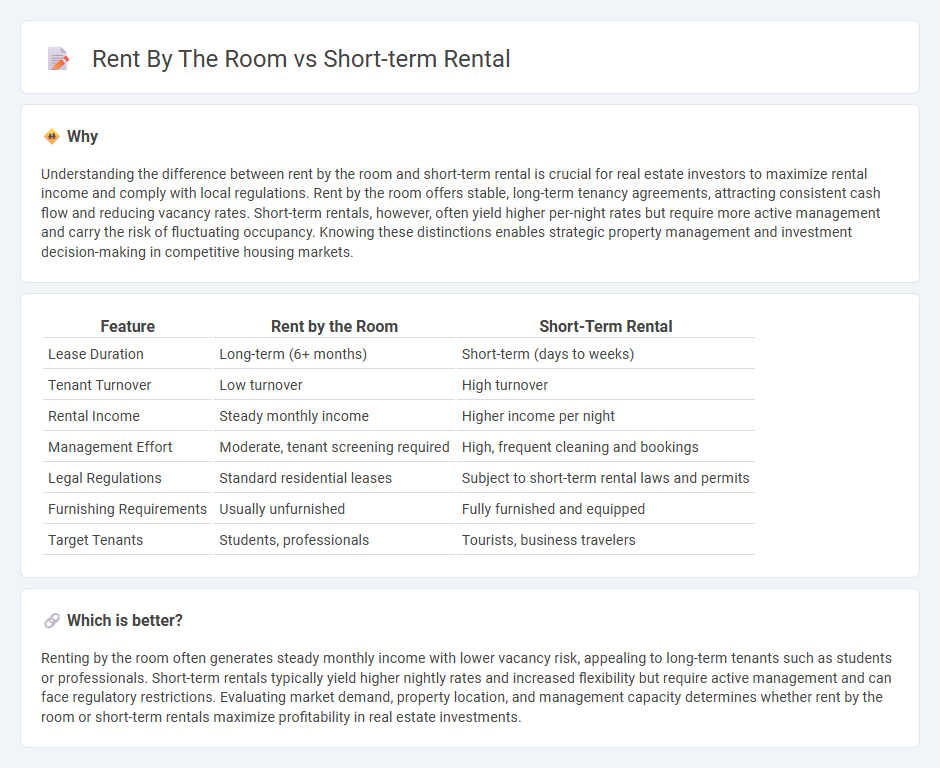
Renting by the room offers affordable, long-term housing solutions with shared amenities, appealing to students and professionals seeking cost-effective living arrangements. Short-term rentals provide flexible, fully furnished accommodations ideal for travelers and temporary residents desiring convenience and privacy. Explore the benefits and considerations of each rental option to determine the best fit for your housing needs.
Why it is important
Understanding the difference between rent by the room and short-term rental is crucial for real estate investors to maximize rental income and comply with local regulations. Rent by the room offers stable, long-term tenancy agreements, attracting consistent cash flow and reducing vacancy rates. Short-term rentals, however, often yield higher per-night rates but require more active management and carry the risk of fluctuating occupancy. Knowing these distinctions enables strategic property management and investment decision-making in competitive housing markets.
Comparison Table
| Feature | Rent by the Room | Short-Term Rental |
|---|---|---|
| Lease Duration | Long-term (6+ months) | Short-term (days to weeks) |
| Tenant Turnover | Low turnover | High turnover |
| Rental Income | Steady monthly income | Higher income per night |
| Management Effort | Moderate, tenant screening required | High, frequent cleaning and bookings |
| Legal Regulations | Standard residential leases | Subject to short-term rental laws and permits |
| Furnishing Requirements | Usually unfurnished | Fully furnished and equipped |
| Target Tenants | Students, professionals | Tourists, business travelers |
Which is better?
Renting by the room often generates steady monthly income with lower vacancy risk, appealing to long-term tenants such as students or professionals. Short-term rentals typically yield higher nightly rates and increased flexibility but require active management and can face regulatory restrictions. Evaluating market demand, property location, and management capacity determines whether rent by the room or short-term rentals maximize profitability in real estate investments.
Connection
Rent by the room and short-term rental both maximize property income by targeting flexible leasing options and diverse tenant needs, often appealing to students, travelers, or professionals seeking affordability and convenience. These rental strategies leverage the demand for customizable living spaces, enabling landlords to optimize occupancy rates and increase cash flow. Shared housing environments and dynamic pricing models further link these approaches in the evolving real estate market.
Key Terms
Lease Agreement
Short-term rental agreements typically offer flexible lease terms ranging from a few days to several months, catering to travelers or temporary residents, while rent by the room involves longer lease commitments, often six months to a year, with individual agreements per occupant. Lease agreements for short-term rentals emphasize transient occupancy rules, cleaning fees, and utilities included, whereas rent by the room leases detail shared space usage, individual payment responsibilities, and tenant conduct within a shared property. Explore the distinct legal obligations and financial responsibilities in each lease type to choose the best rental arrangement for your needs.
Occupancy Type
Short-term rental occupancy type typically caters to transient guests seeking accommodations for days to weeks, ideal for travelers or temporary stays, while rent by the room targets long-term tenants sharing a residential unit with private or shared spaces. Short-term rentals often feature flexible booking durations and amenities catering to short stays, contrasting with rent by the room arrangements emphasizing personalized living spaces within a shared home environment. Explore more on optimizing occupancy strategies for different rental types to maximize profitability and tenant satisfaction.
Income Structure
Short-term rentals typically generate higher daily income due to flexible pricing and high occupancy rates on platforms like Airbnb, whereas rent by the room offers steady, predictable monthly cash flow from multiple tenants. Income from short-term rentals fluctuates with seasonal demand and local events, while rent by the room provides more consistent revenue with reduced vacancy risk. Explore detailed income analytics and optimization strategies for both rental models to maximize your real estate returns.
Source and External Links
What is Considered a Short-Term Rental? - GovOS - Short-term rentals include entire homes, accessory dwellings, or rooms rented out for short stays, either in an owner-occupied or non-owner-occupied property, usually with limits on maximum days rented per year.
Short-Term Rental | Atlanta, GA - Atlanta's ordinance requires short-term rental hosts or agents to apply for a license and follow city regulations for renting out primary residences or one additional dwelling unit legally.
Short Term Rentals in Lawrenceville, GA - Monthly, Weekly, Daily - Lawrenceville offers furnished short-term rentals with flexible lease lengths from nightly to monthly stays, requiring adherence to the lease contract between tenant and property owner.
 dowidth.com
dowidth.com